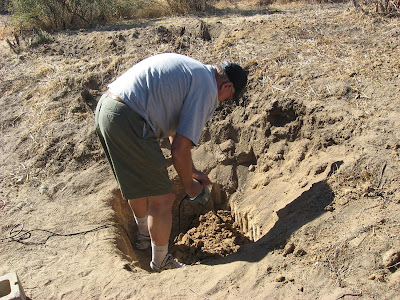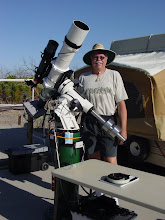 Stairs are completed except for the bottom floor platform.
Stairs are completed except for the bottom floor platform.The day was gorgeous - I think I know why people live there despite the amazing heat of June thru August - the rest of the year is terrific. Saturday was terrific - bright blue sky, 75 degrees, low humidity, and a light cool breeze.
Saturday also marked a milestone - the final demolition was 99% completed with the removal of the last roof eave from the warm room roof. The remaining 1% are the two top plates on the east and west walls which will stay in place until we are actually ready to install the steel rail structure.
 Dropped eave on the left next to our debris pile.
Dropped eave on the left next to our debris pile.Most of the eight hours we worked involved excavation. We have two post holes to dig to support the two posts that will support the rail system that will extend to the north of the building for five feet. As can be seen from the photo below where John has just started to dig below grade after excavating the loose soil, there is a steep five foot slope immediately behind the north wall that we had to excavate through just to get to the observatory floor level. Based on the loose soil that made up the slope we removed, the plan was to dig footings three feet across and up to two feet deep.
 John using the jack hammer as he digs below grade
John using the jack hammer as he digs below gradeHowever, once we dug down to grade, the loose soil ended and we reached what is commonly called "desert pavement" - fine grains of rock that have gradually glued together with "desert varnish" over a long period of time. Not even a pick helped to break up this stuff. Fortunately, we had a small jack hammer that we used extensively. John used the jack hammer to break up a few inches of the rock, then I cleared out the loosened rock. Back and forth for hours. By the end of the day we ended up excavating about 15 inches with one hole. Since we were going into solid rock, we decided 15 inches was deep enough for the footing.
 Tom using a small jack hammer in hole
Tom using a small jack hammer in holeWe called it a day at that point. Below you can see the near hole only;y had the slope cleared down to grade while the further hole is full excavated. Notice below that we threw much of the cleared rock on top of the slope to serve as a berm to direct any water flow away from the observatory.
 The holes don't look like anything much but that was almost 8 hours work by two people with a power tool. Our next step is to complete the second hole next weekend. After that we will either proceed with pouring the footings and erecting the support posts or spray painting the observatory exterior.
The holes don't look like anything much but that was almost 8 hours work by two people with a power tool. Our next step is to complete the second hole next weekend. After that we will either proceed with pouring the footings and erecting the support posts or spray painting the observatory exterior.

No comments:
Post a Comment